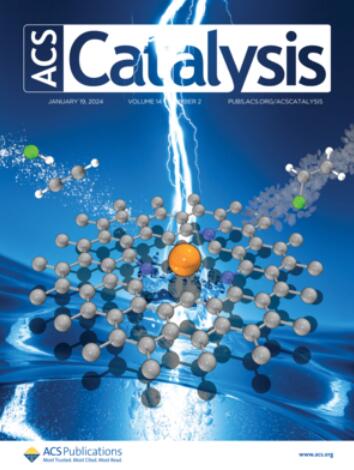Light-Driven Synthesis of 2-Aminoethanol from Formaldehyde and Ammonia
IF 11.3
1区 化学
Q1 CHEMISTRY, PHYSICAL
引用次数: 0
Abstract
Amino alcohols are widely used in chemical and pharmaceutical industries, while conventional synthesis methods face drawbacks such as low selectivity and high energy consumption. Multienzyme catalysis combined with light-driven cofactor regeneration affords a platform of light-driven synthesis of chemicals, where the transfer of electrons and protons as well as the route of enzymatic reactions dominates the energy conversion efficiency and atomic economy of carbon utilization. Herein, we construct a light-driven synthesis system comprising an energy-supplying module and a multienzyme catalytic module for 2-aminoethanol synthesis from formaldehyde and ammonia. First, a S-scheme heterojunction photocatalysts with a metal–organic framework core and a bipyridine-based conjugated polymer shell are prepared as an energy-supplying module. Through synergistic intensification of proton transfer and electron transfer, the photocatalysts render cofactor (NADH) regeneration efficiency with a turnover frequency of 30.49 h–1. Second, a multienzyme catalytic module is constructed for 2-aminoethanol synthesis in the presence of NADH. Under optimal conditions, this module produces 2-aminoethanol with an average reaction rate of 76.34 μmol L–1 h–1 within 24 h. Finally, the energy-supplying module is coupled with the multienzyme catalytic module for continuous synthesis of 2-aminoethanol from formaldehyde and ammonia, generating 0.55 mmol L–1 2-aminoethanol after 4 light–dark cycles. In addition, triethanolamine (TEOA) and glucose, a biomass-derived carbon source, are both confirmed as effective electron donors for NADH regeneration and light-driven synthesis system. This work opens a pathway for the synthesis of amino alcohols and demonstrates a paradigm for the intensification of reaction processes.

甲醛和氨光催化合成2-氨基乙醇
氨基醇广泛应用于化工和制药行业,但传统合成方法存在选择性低、能耗高等缺点。多酶催化与光驱动辅因子再生相结合,为化学物质的光驱动合成提供了平台,其中电子和质子的转移以及酶促反应的途径主导着碳利用的能量转换效率和原子经济性。在此,我们构建了一个由能量供应模块和多酶催化模块组成的光驱动合成系统,用于甲醛和氨合成2-氨基乙醇。首先,制备了具有金属-有机骨架核心和联吡啶基共轭聚合物外壳的s型异质结光催化剂作为供能模块。通过质子转移和电子转移的协同增强,光催化剂的辅助因子(NADH)再生效率达到30.49 h-1。其次,构建了在NADH存在下合成2-氨基乙醇的多酶催化模块。在最优条件下,该模块在24 h内平均反应速率为76.34 μmol L-1 h - 1,生成2-氨基乙醇。最后,供能模块与多酶催化模块耦合,由甲醛和氨连续合成2-氨基乙醇,经过4个光-暗循环,生成0.55 mmol L-1 2-氨基乙醇。此外,三乙醇胺(TEOA)和葡萄糖(一种生物质来源的碳源)都被证实是NADH再生和光驱动合成系统的有效电子供体。这项工作为氨基醇的合成开辟了一条途径,并为强化反应过程展示了一个范例。
本文章由计算机程序翻译,如有差异,请以英文原文为准。
求助全文
约1分钟内获得全文
求助全文
来源期刊

ACS Catalysis
CHEMISTRY, PHYSICAL-
CiteScore
20.80
自引率
6.20%
发文量
1253
审稿时长
1.5 months
期刊介绍:
ACS Catalysis is an esteemed journal that publishes original research in the fields of heterogeneous catalysis, molecular catalysis, and biocatalysis. It offers broad coverage across diverse areas such as life sciences, organometallics and synthesis, photochemistry and electrochemistry, drug discovery and synthesis, materials science, environmental protection, polymer discovery and synthesis, and energy and fuels.
The scope of the journal is to showcase innovative work in various aspects of catalysis. This includes new reactions and novel synthetic approaches utilizing known catalysts, the discovery or modification of new catalysts, elucidation of catalytic mechanisms through cutting-edge investigations, practical enhancements of existing processes, as well as conceptual advances in the field. Contributions to ACS Catalysis can encompass both experimental and theoretical research focused on catalytic molecules, macromolecules, and materials that exhibit catalytic turnover.
 求助内容:
求助内容: 应助结果提醒方式:
应助结果提醒方式:


